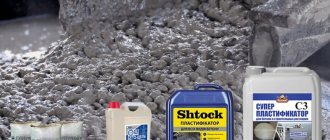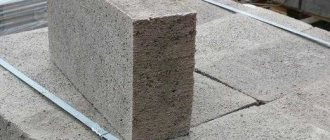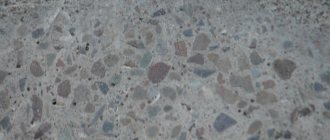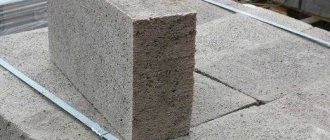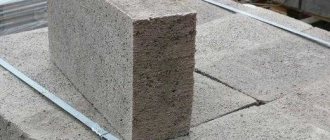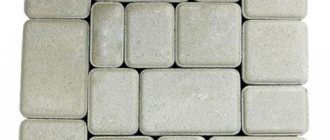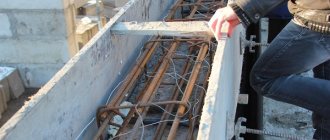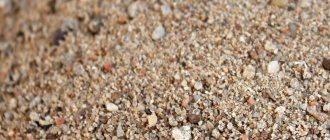Laboratory testing of concrete cubes for strength helps determine the maximum permissible load on the product. Through a series of experiments, the basic properties and characteristics of materials are learned. Samples in the form of cubes undergo certain preparation and exposure periods. The results obtained help determine the area of use of grades and classes of concrete mortar.
Construction department
Preparation of samples (cubes) for testing concrete.
Laying hard (rammed) concrete into forms was carried out with 20 cm cubes in two layers of 12 cm thickness each, with 30 cm cubes in two layers of 18 cm each. With a 20-cm cube, each layer had to be compacted with 48 blows, which corresponded to 1 kgm of work per 100 g of mixture.
Laying of plastic and cast concrete was also carried out in two of the same layers. Each layer had to be pierced 56 times (with a cube of 30 cm - 112 times) with an iron rod with a diameter of 10-16 mm with a round-pointed end.
After compacting or pinning the last layer, the surface of the cube was leveled with a metal ruler.
After this, the cubes were left for another 24 hours on the bottom board, and then carefully removed and stored until testing in wet sand or wet sawdust at a temperature of +15-20 ° C.
How to test concrete for strength?
There are currently two types of testing:
- Destructive (laboratory testing);
- Non-destructive (tested at construction site).
Let's consider each type separately.
Testing of concrete using a non-destructive method.
- Plastic deformation. Allows you to determine strength in the range of 5-50 MPa . With this method, the value is determined by the diameter of the imprint of the steel ball left after the ball hits its surface. The method has little accuracy. Therefore, despite its simplicity and low cost, it is rarely used;
- Elastic rebound. The range of measured strength is similar to the plastic deformation method. The essence of the method is to measure the rebound parameter of a special striker from the surface of the structure being tested. The main advantages are low cost and high measurement accuracy;
- Shock-pulse method. Allows determination in a wide range from 50 to 150 MPa . The essence of the method is to measure the impact energy of a special elastic body on the concrete surface. Among the advantages: the compactness of the measuring equipment, simplicity, low cost and the ability to calculate the reliability of concrete “in compression”. One of the most popular methods for measuring strength among builders;
- Ultrasonography. Allows you to check not only a single surface, but also the entire structure as a whole.
- "Rib chipping" technology. The range of measured values is from 10 to 70 MPa . This method measures the force that must be applied to shear the edge of a concrete structure: beams, piles, lintels or columns. The method is highly accurate, labor-intensive and cannot be used for damaged concrete structures or structures with a protective layer of up to 22 mm ;
- Separation with chipping. Measuring range from 5 to 100 MPa. The essence is that a special anchor embedded in the thickness of concrete acts on the structure until the sample is torn off or a given strength value of the product being tested. It is distinguished by a high degree of accuracy and increased labor intensity;
- Separation of an iron disc. Strength measurement range from 5 to 60 MPa. Allows you to check reinforced concrete to which it is impossible to apply other control methods. The essence of the technology is to measure the load that must be applied to tear off the glued steel disk from the concrete surface. It is distinguished by high accuracy and a long preparatory period - from 4 to 22 hours.
To obtain results when using non-destructive testing methods, special instruments and devices are used. Partial destruction is carried out by fixing a special tool on the concrete surface, which allows you to examine it for tearing, fixing the required force.
Destructive testing methods according to GOST.
The essence of the methods is to study samples obtained by drilling or sawing from a finished structure. They are subjected to a static load with a gradual increase in the growth rate. As a result, it is possible to calculate the stresses under the applied forces.
The dimensions and shape of the samples taken depend on the type of tests being performed. They must meet the requirements of GOST 10180 .
Research method
Shape of test samples
Dimensions of elements in millimeters
To determine strength, its samples are collected by drilling or sawing out individual parts:
- Places are assigned after a preliminary inspection. The testing area for the structure should be located at some distance from joints and edges.
- The remaining grooves after taking samples are walled up with fine-grained concrete.
- During the drilling or sawing process, saws with diamond blades, special bits or suitable carbide tools are used.
- There should be no fittings at sampling areas. If this option cannot be implemented, then a piece of concrete with metal rods with a cross-section of up to 16 mm is taken for samples with dimensions greater than 10 cm.
- The presence of reinforcement is unacceptable when testing for axial tension and compression. This has a negative impact on the final results. In addition, rods should not be present in prism-shaped specimens used in flexural tensile tests.
- The locations for extracting samples, their quantity, and dimensions are determined by control rules taking into account the points of GOST 18105 .
Each piece taken is marked and described in the protocol. After this, it undergoes thorough preparation for further testing. All samples must have a special diagram that clearly reflects the orientation of the parts directly in the structure.
Strength of concrete
I recently got a new job as a technical equipment engineer, and currently we are doing work on laying foundations for metal supports for a pipeline. To prepare construction documentation, you have to delve into all these subtleties.
Concrete is tested by several methods in accordance with GOST R 53231-2008 “CONCRETE. Rules for monitoring and assessing strength":
3.14 destructive methods for determining the strength of concrete: Determination of the strength of concrete using control samples made from a concrete mixture in accordance with GOST 10180 or selected from structures in accordance with GOST 28570.
3.15 direct non-destructive methods for determining the strength of concrete, which do not require mandatory calibration: Determination of the strength of concrete by “tearing with shearing” and “rib shearing” according to GOST 22690.
1.3. Mechanical non-destructive testing methods are used to determine the strength of concrete of all types of standardized strength, controlled according to GOST 18105-86, as well as to determine the strength of concrete during inspection and rejection of structures.
The test method should be selected taking into account the maximum strength values recommended by the manuals for specific non-destructive testing devices, in accordance with the requirements of Section. 3 of this standard.
(Revised, Amendment 2009)
How to take concrete samples for the laboratory can be found in GOST 10181-2000 “CONCRETE MIXTURES. Test methods".
3 Rules for sampling and testing
3.1 Concrete mixture samples for testing during production control should be taken:
- in the production of prefabricated and monolithic products and structures - at the site of laying the concrete mixture;
- when dispensing ready-mix concrete - at the place of its preparation when loading into a transport container.
3.3 The volume of the sample taken must provide at least two determinations of all controlled indicators of the quality of the concrete mixture.
3.4 The selected sample must be additionally mixed before testing.
Concrete mixtures containing air-entraining, gas-forming and foam-forming additives, as well as preheated mixtures, are not mixed before testing.
3.5 Testing the concrete mixture and making control samples of concrete should begin no later than 10 minutes after sampling.
3.6 The temperature of the concrete mixture from the moment of sampling to the end of the test should not change by more than 5 °C.
3.7 The storage conditions for the concrete mixture sample after its collection until testing must prevent loss of moisture or wetting.
3.8 Verification of measuring instruments and certification of testing equipment should be carried out in accordance with GOST 8.001, GOST 8.326, GOST 8.383.
3.9 The results of determining the quality indicators of the concrete mixture must be entered in a journal in which they indicate:
— name of the organization producing the mixture;
— name of the concrete mixture according to GOST 7473;
— name of the quality indicator being determined;
— date and time of testing;
— sampling location;
— temperature of the concrete mixture;
— results of partial determinations of individual indicators of concrete mix quality and arithmetic average results for each indicator.
We have sorted out the concrete samples for the laboratory, but the question remains open whether concrete should be tested for strength after 7 days, maybe the answer will be found in SNiP 3.03.01-87 “LOAD-LOADING AND ENCLOSING STRUCTURES”, but apart from this entry nothing else is written:
TESTING OF CONCRETE DURING ACCEPTANCE OF STRUCTURES
2.18. Strength, frost resistance, density, water resistance, deformability, as well as other indicators established by the project, should be determined in accordance with the requirements of current state standards.
It is not clear in which GOSTs to look for answers, we continue to search further. We read SP 52-101-2003 clause 5.1.4 “CONCRETE AND REINFORCED CONCRETE STRUCTURES WITHOUT PRE-STRESSING REINFORCEMENT”:
Kawabanga! Concreting quality control
It turns out that if the project does not indicate that the strength of concrete after 7 days should be equal to some value, then concrete cubes should not be taken to the laboratory for strength testing and the desire of technical supervision can be answered with a refusal.
How we took the cubes to the laboratory to test the strength of concrete.
And then the builders remember that during pouring they did not make concrete cubes and in general there were no metal forms at the construction site. I often found myself in such a situation; often I simply lost my cubes.
If everything is very serious and there are no concrete cubes, then they call a laboratory to the site and test the concrete using an indestructible method, or cut cores from the concrete structure using diamond drilling and take them for testing.
I will be glad to see your additions in the comments on the topic of testing concrete for strength.
Sincerely, Oleg Klyshko
Concrete testing GOST 10181.1-81
Concrete performance testing in accordance with the requirements of this regulatory document is carried out by concrete plant laboratories immediately after preparing the commercial solution.
- Cone draft. Using this method, the heterogeneity and consistency of the material is determined. These indicators affect the workability of concrete. The essence of the method is to fill a metal cone with the concrete being tested, measure linear indicators after removing the shell (cone) and compare the change in dimensions of the resulting “concrete easter” with tabulated values.
- Compaction test. This method allows you to set the compaction coefficient of a specific batch of building material. To determine this characteristic, the following technological equipment is used for testing concrete - an apparatus consisting of two measuring containers with funnels. The substance to be tested is poured into the first funnel. The funnel has a valve through which the solution flows into a second funnel into a container of smaller volume. Next, the material being tested falls into a special cylindrical form. The density and compaction coefficient of a solution in a cylindrical form is calculated mathematically.
- Plasticity and shape change test. In this case, the material to be tested is poured into a test cone of certain dimensions, which is installed on a special support table. The table has the ability to move down a few centimeters when shaken. Next, the form is carefully removed and the table is lowered. Concrete spreads over its surface. By carrying out linear measurements of the average diameter of the “spreading” form of concrete, the plasticity indicators of the material being tested are determined.
- Checking for air voids in concrete mortar. Two methods are used. The first method is to measure the weight of a concrete sample before and after shaking and stirring using a pycnometer. Accordingly, to assess the presence of air in this way, very precise instruments are used that can determine a slight deviation in mass. The second method is the pressure method. In this case, special air meters are used that show the content of air voids in the body of solid concrete.
For private developers who are dealing with concrete for the first, often the last time in their lives, we can recommend the following quality control (testing) of concrete using the “empirical” method:
- Color. High-quality concrete should have a gray-greenish color. Moreover, the “greener” the concrete delivered, the better its quality. The yellow tint of concrete is a sign of its unworthy quality.
- The so-called “cement laitance” should appear on the surface of the laid concrete. The thicker the material, the higher the quality of the concrete.
- There should be no filler fractions not covered with a mixture of cement and sand.
- After the concrete has completely hardened, the steel hammer should bounce off the surface with a ringing sound, leaving a shallow dent.
Determination of concrete strength - testing methods and instruments
What affects strength?
A concrete mixture hardened under construction site conditions may produce results that differ from laboratory results. In addition to the quality of cement and aggregates, the characteristics are affected by:
The quality of the mixture and its strength characteristics deteriorate if gross violations of technology were committed during the work:
Improper transportation leads to setting, separation and loss of mobility of the mixture. Without compaction, air bubbles remain in the thickness of the structure, which deteriorate the quality of the monolith.
Sample forms
The formwork for pouring test cubes is made from wooden boards. On the scale of a plant or factory, it is preferable to use metal parts. The shape is cubic, the wall dimensions are 20*20 or 30*30 centimeters. The length depends on the list of experiments. According to the standard, a cube with one cell is chosen. If it is necessary to test a large number of samples, use forms with 2-7 cells for the concrete mixture. Such designs help save time. Their size is different and varies depending on the required parameters of the cube.
Special shapes for such products must be cubic.
Cubic strength of concrete: testing methods, strength indicators.
The main indicator of the strength and deformability of concrete is its resistance to axial compression. The remaining strength characteristics (resistance to tension, local compression, etc.) are determined by the strength of concrete specifically in axial compression.
A simple way to test concrete strength
For testing, cubes are taken on the 28th day after hardening and tested in conditions close to normal (air temperature 15-20 ℃, air humidity 90-100%). The pressure resistance coefficient is the cubic strength of concrete
.
With the development of modern technologies, new methods for assessing the strength of concrete without physical impact are emerging. Concrete is subjected to ultrasound, illuminated with penetrating rays, etc.
Cubic strength indicators
This difference in results is due to the influence of the friction force that arises between the faces of the experimental cube and the press plates - the larger the face, the greater, accordingly, the friction force. Much also depends on the structure of the concrete.
Important! If samples are tested larger or smaller than the reference size, then the obtained tensile strength figures are multiplied by the corresponding coefficient.
Compression performance
It is compression and pressure that concrete is usually subjected to in real conditions. Compressive strength indicators are usually 8-20 times higher than tensile strength.
A cube with an edge length of 15 cm is considered to be a reference sample, but in general cubes larger and smaller are tested. Concrete cylinders of different sizes are also tested.
The video will show how concrete strength testing occurs in practice.
Manufacturing
Depending on the required number of properties that need to be determined, the cubes come with a side of 20 or 30 centimeters. The form must be filled with a rammed type solution from a given height. The distance for a twenty-centimeter sample is 15 cm, for a thirty-centimeter sample - 25 cm. The layered filling method is encouraged. Each ball of the mixture is compacted using blows. After the cube is completely filled, the surface is leveled using a ruler. The walls of the cube can be removed 1-2 days after pouring. The concrete mixture hardens within 28 days under normal climatic conditions. The test press includes impacts. Under normal conditions, 48-56 strokes are sufficient. Complete instructions for preparing cubes are contained in GOST 22685–89.
View "GOST 22685-89" or
What is concrete class
Classes and grades of concrete
When ordering a floor brand with minimum strength, the customer signals a deliberate reduction in the required indicators, which has a negative impact on the durability and operational safety of the building.
To eliminate the described problems, the ensured strength of concrete is used - the most objective and universal definition, called the class of concrete for pouring floors.
What determines the strength of precast concrete?
Scheme of the main types of concrete macrostructure
If you set a strength class of 80 kg, then 95% of the floor area will have a strength higher than this indicator. Concrete class is a statistical concept.
Prices for cement M500
How is concrete class determined?
Our country has outdated standards; no one uses such methods in developed countries anymore. The class of concrete is determined by the formula B = M (1-v×t) . Where:
- B – concrete class;
- M – concrete grade;
- v – coefficient of variation;
- t – security.
Concrete strength gain schedule
Why are they needed?
Concrete samples are most often used in laboratory tests. With their help, the cube and prismatic strength of concrete can be measured. In the first option, samples in the form of cubes are used, in the second - in the form of prisms with given side sizes. Compression resistance shows what loads the finished structure can withstand. Based on the results obtained, builders assume the likelihood of using a concrete grade in a certain construction process.
With the help of such elements, the material is tested for compression.
Quality control allows us to guarantee the durability of the structure and avoid premature destruction.
Calculation of concrete composition
What is this brand of mixture used for?
Any builder, or even a simple craftsman carrying out small “household” work, has encountered such mixtures. Therefore, the M200 mixture has rightfully earned such a characteristic as versatility.
Its use on a construction site or in precast concrete factories is quite common:
As we can see, the M200 brand mixture is applicable at different stages of construction, from underground to above-ground cycle.
Self-production of concrete M200
The price of home-prepared mixtures may be lower than purchased ones. But not always.
It may be disadvantageous to the manufacturer for several reasons:
What is more profitable in such a situation is, again, up to you to decide.
To find your ideal recipe for M200 concrete per 1 cubic meter, it is not enough to have a good technical and economic base. It is also necessary to understand the regulatory documentation, which reflects the basic standards and characteristics of concrete.
Selection of composition
For those who want to learn how to make a good selection of concrete composition themselves, to “get a feel for it,” we will give a small recommendation. Having such a starting point, you can use trial and error to understand how to prepare and what class of concrete is needed in each specific case.
Let us roughly divide such a technological process into several stages.
- Stage 1. First batches Having decided on the materials, we proceed to selecting the composition. It is necessary to determine a preliminary recipe, how much cement is used per 1 m 3 of M200 concrete, and make a test batch in a small amount.
So, the consumption of materials per 1 m3 of M200 concrete is approximately the following:
- cement consumption per cube of concrete M200 - 310 kg;
- sand - 864kg;
- crushed stone −1218kg;
- water - 158l.
The standard ratio is 1: 2.8: 3.9: 0.5, using 1 part of cement as the basis. At the same time, for a test batch we use a few components - enough to make 6 cubes for further testing.
The hardening time of M200 concrete ranges from 1.5-2.5 hours. This parameter depends on the hardening conditions - air humidity, temperature.
It is also important: whether the composition is subjected to heat and moisture treatment, electrical heating, or whether the strength gain occurs through natural hardening.
Definitions
Cubic strength is the axial compressive (tensile) strength. This characteristic is determined on cubic samples with accepted standard dimensions of 15x15x15 cm. However, sometimes, in the case of very small or, conversely, very large filler, the edges of the cube can have a size of 10 or 20 centimeters. In this case, for testing samples with such dimensions, a correction factor is introduced equal to
- for cubes with a side of 10 cm K≈0.90,
- with a side of 20 cm K≈1.1.
The sample is centered on the press support plate along its geometric axis and is subjected to pressure loading corresponding to a stress increase of 0.3: 0.4 MPa/sec, that is, in the range from 6.75 to 9.0 kN/sec on the scale of measuring force to failure .
The calculation is carried out using a formula that takes into account the tensile strength of each sample ( R=frac>K ) MPa, in which
- F – load preceding sample failure, expressed in kN;
- A is the cross-sectional area of the sample before failure, expressed in cm 2 ;
- K – conversion factors from the tested cubes to the reference cube with a standard edge of 15 cm.
Cubic strength calculations are made based on the arithmetic mean value in series of three or more samples. If the test results of one of the samples differ from the neighboring sample by more than 15%, the sample is rejected. And if the neighboring indicator differs from the next one also in a larger direction and by the same 15%, the entire series of tested samples is rejected.
Near the press support plates (upper and lower), the friction force directed inside the prism between the sample and the plates creates something like two truncated pyramids directed at each other, a cage effect, which increases the compressive strength of the samples (option “a”). Add any lubricant to the supporting planes - and the nature of the destruction will change, the cube will split along planes parallel to the vector of the applied force (option “b”). The thick black stripe in version 2 is lubricant applied to the supporting edges.
However, in reality, the shape of reinforced concrete structures only in rare cases repeats the shape of the tested reference samples. Therefore, in tests and calculations, the prismatic strength Rb is used.
With the “height-to-base” aspect ratio, when the length of the sides of the base is always less than the length of the height of the tested samples, for samples of shapes close to the prism, the load on the bases at the moment of compression is always less than on the edge of the prism in height. This is perfectly demonstrated by practice, when the stress in the compressed zone of concrete products is close to the state of prisms under compression. That is, prisms and forms conventionally close to them will always demonstrate lower compressive strength. If the height of the prism is related to the sides of the base as h/2˃4, the friction force has practically no effect, and the strength value becomes practically unchanged, equal to ≈0.75R.
Prismatic strength Rb is calculated using a similar formula as the quotient of the magnitude of the breaking load divided by the cross-sectional area of the sample.
Graph of the dependence of the prismatic strength of concrete on the ratio of the dimensions of the tested sample
What does the strength of concrete depend on and what influences it?
Sometimes builders, when carrying out work, try to save on materials by using cheaper, low-grade concrete, but violating the design values can lead to serious consequences, so such a means of saving is unacceptable.
Kawabanga! SP Concrete and reinforced concrete structures
In addition to the composition of the solution, the strength of concrete is influenced by the external conditions under which the pouring is carried out. With high-quality removal of air bubbles from the concrete mass by compacting the mixture, the strength of the products increases noticeably.
Test stages
Concrete testing is carried out by examining samples for strength using non-destructive and destructive methods.
Destructive methods
This method is the most accurate and mandatory when carrying out work on the construction of critical structures.
Non-destructive methods
The reaction of the material to shearing is also studied when the device is installed on the corner of a concrete base and the material is destroyed under load.
Separation with chipping.
Under shock loads, the behavior of concrete during impact is studied with a special device and the reaction to elastic rebound is recorded - the value of the rebound of a metal ball released with a certain force is measured.
During ultrasonic quality control of concrete, a special device is used that makes it possible to record the passage of waves inside the structure. Based on the reaction to reflection, a conclusion is drawn about the quality of the material.
Under impact loads (hitting a material that has gained full strength with a hammer), the tool should bounce off the base without significant changes on the surface, leaving almost invisible dents.
Methods for direct non-destructive testing of concrete
Direct control of concrete strength includes tests:
- On the break . They are made by gluing a metal disk with epoxy glue. Using devices POS-50MG4, GPNV-5, PIV, the disk is torn off together with the concrete element. The resulting force value is converted into strength using formulas.
- For tearing off with a chip . In this case, petal anchors are placed in the drilled hole. The anchor is pulled out along with the material, the force is recorded, and it is converted into a strength characteristic using formulas.
- Rib chipping . This method is well suited for structures with external corners - columns, beams, floors. The device is fixed to the protruding part of the structure using an anchor with a dowel.
Concrete strength grades and their scope of application
According to its strength characteristics, concrete is divided into grades from M100 to M500 in increments of 50. Another characteristic, the concrete class, determines the ability of the material to work in aggressive environments.
Concrete grades M100, M150, M200 and M250 are classified as light and cellular. They are used for pouring structures that do not bear a significant load. They are used for constructing curbs, foundations for small buildings, and pedestrian paths.
Concrete M300 and M350 can be used for casting floor slabs, constructing foundations in multi-story construction, and casting monolithic walls.
The most durable concrete grades, M400, M450 and M500, are used in the production of reinforced concrete structures operating in difficult conditions with increased load (for example, for the construction of hydraulic structures).
Control methods
Overview of methods
Today, strength is determined using several methods.
Concrete cylinder destroyed under pressure
Note! The disadvantage of this group of methods is the complexity of sample extraction and the high cost of the procedure. In addition, if the sampling point is incorrectly selected, there is a risk of reducing the load-bearing characteristics of the structure as a whole.
- Unbrakable control. This group of methods differs from the previous two in that it is not the strength of concrete itself that is measured, but other indicators that are directly related to mechanical stability. Non-destructive testing methods are less labor-intensive, but their accuracy will be somewhat lower. However, it is quite sufficient for solving most engineering problems.
All these methods can be used in both mass and private construction. The procedure for carrying out control activities is regulated by GOST R - 53231-2008 “Control and assessment of the strength of concrete” and a number of other standards.
Non-destructive measurement methods allow you to work with already erected structures
Sample production and processing
The most common method is to test the strength of concrete cubes.
To do this, perform the following preparatory work:
- Several concrete samples are taken from a batch of mortar, the volume of which will be sufficient to produce a series of samples of the required size.
Note! When selecting material, it should not be additionally mixed, removed or added filler, etc.
- By pouring into standardized forms, samples are made, the configuration and dimensions of which correspond to the type of study. As a rule, forms are filled out no later than 20-30 minutes after selection.
Regulatory documents allow the use of the following control samples:
Schemes for cutting down monoliths
- The instructions allow for testing samples that do not have visible defects - chips, cracks, cavities with a diameter of more than 10 mm, etc.
Note! The presence of solution sagging on samples obtained by casting into a mold is allowed, but before testing they must be removed using an abrasive.
Laboratory testing of working solution
Control begins from the moment of its preparation.
Note! The frequency and volume of sampling for further testing depends on the type of structure being manufactured, compaction, exposure, driving method, and many other factors. But at least once during the manufacture of one batch of products. The technologist and the head of the laboratory establish internal regulations and procedures in accordance with which sampling is carried out.
When producing prestressed reinforced concrete products, it is necessary to make samples for each pour in order to establish the time of destressing of the product using laboratory control.
Depending on the type of production and manufactured products, there are different selection rules:
- In the production of ready-mixed concrete, fences are made directly from the batching unit during the shipment of the solution.
- In factories during the production of prefabricated reinforced concrete, it is allowed to take the working mixture directly from the mixer, during dispensing, or from a bucket.
Note: Ideally, samples should be taken from three stages of production. But sometimes, in large enterprises where all work processes are automated, getting to the BSU for sampling is not so easy. Therefore, samples are taken from three average batches during distribution or molding.
- In the production of monolithic reinforced concrete, selection is carried out when laying the mixture. Already compacted material will not give reliable results, so it is best to take the solution from the next batch.
The volume of material selected for the production of control samples must be within officially established limits:
- when manufacturing products with a volume of more than 2 m 3, more than three series of samples are required;
- one series of samples for the volume sold to the consumer - in this case there should not be more than 50 m 3 of samples from one brand;
- in the manufacture of monolithic structures, depending on the volume of products produced, there must be at least one series of samples per product.
If the material is produced at a construction site, it is collected into an ordinary tin bucket (or buckets) and taken to the laboratory urgently - until the cement laitance appears on the surface. According to the rules, of course, it is necessary for a mobile laboratory to come to the site - but what is not there is not there. Especially in small towns.
When sampling has been carried out, the first control measures can begin.
Determination of workability
Not only in laboratories, but also on construction sites, tests are carried out for workability and rigidity. The data obtained gives digital values in centimeters, which can be classified and a grade assigned to the prepared material according to its mobility.
The process is not complicated and training as a laboratory assistant is not required. You just need to have certain knowledge, which we will share.
To do this, according to GOST 10181−2014, you will need:
- Special conical shape with stops. You can make it yourself, following the exact recommendations of the standard. But you can take a simpler route and purchase it in specialized stores. The price for it is not that high.
- Two steel, preferably verified rulers.
- Trowel.
- Construction funnel.
- Metal rod.
Stages of work:
- Stage 1. The mixture is applied into the cone using a funnel until it is completely filled, and thoroughly bayoneted 25 times along the entire length and area of the lower layer.
- Stage 2. Remove the funnel and carefully remove the excess mixture with a ruler.
- Stage 3. With a gentle movement, lift the cone strictly horizontally and place it next to the material.
- Stage 4 . Concrete begins to settle under its own weight. This process does not need to be hindered. And as soon as it ends, continue the event.
- Step 5. Place a ruler on the top of the cone so that the difference in height between the sample and the cone can be measured. Measurements are carried out with an accuracy of millimeters.
- Step 6. A similar process is repeated twice, and the last value is taken as the arithmetic mean between the two. If the results differ too much - more than 2 cm, then the event is repeated with a new sample.
- Stage 7. The resulting value in centimeters is the mobility of the mixture.
Depending on it, mixtures are:
- flowing (cast) – OK from 21 cm;
- mobile - OK 10–16 cm;
- moderately mobile - OK 6–9 cm;
- sedentary - OK 1–5 cm;
- moderately hard, hard, extremely hard and especially hard mixtures - OK 0 cm.
But mobility has its own alphanumeric designation P:
- P1 – 1-4 cm;
- P2 – 5-9 cm;
- P3 –10-15 cm;
- P4 –16-20 cm;
- P5 – 21 cm and more.

